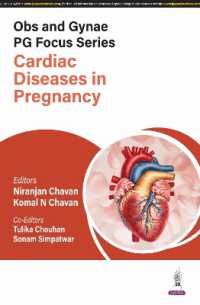- ホーム
- > 洋書
- > 英文書
- > Science / Mathematics
基本説明
Includes coverage on key tropics including environmental impact, air quality issues, green design considerations and coverage of the latest ASHRAE guidelines.
Full Description
Principles of HVAC in Buildings by J. W. Mitchell and J. E. Braun provides foundational knowledge for the behavior and analysis of HVAC systems and related devices. The emphasis is on the application of engineering principles, and features a tight integration of physical descriptions with a software program that allows performance to be directly calculated, with results that provide insight into actual behavior. The examples, end-of-chapter problems, and design projects are more than exercises; they represent situations that an engineer might face in practice and are selected to illustrate the complex and integrated nature of an HVAC system or piece of equipment. Coverage of material applicable to the field is broad: a Fundamentals section on thermodynamics, fluid flow, heat transfer, and psychrometrics; types of HVAC systems and components; comfort and air quality criteria; a Loads section on weather data processing; design heating and cooling loads; an Equipment section on air and water distribution systems, heating and cooling coils, cooling towers, refrigeration equipment, and a Design and Control section on seasonal energy use, control techniques, supervisory control, the HVAC design process, and the rules of thumb often used in design. The textbook provides a foundation for students and practicing engineers to design HVAC systems for buildings. In addition, there is extensive supplemental on-line material that provides more in-depth and comprehensive treatment of equipment and component modeling and performance that is geared towards current and future equipment design engineers.
Contents
Fundamentals
1 Introduction to HVAC Systems 1
1.1 Systems and Definitions 1
1.2 History of Air Conditioning 3
1.3 Trends in Energy Use and Impact 5
1.4 HVAC System Design and Operation 7
1.5 Energy Costs
1.6 Book Philosophy and Organization 11
1.7 Units 13
1.8 Summary 14
Problems 14
2 System Analysis Techniques and the Use of EES 15
2.1 Introduction 15
2.2 Introduction to EES 19
2.3 Common Problems Encountered when Using EES 22
2.4 Curve Fitting Using EES 26
2.5 Optimization Using EES 29
2.6 Successful Problem Solving Using EES 31
2.7 Summary 34
Problems 35
3 Thermodynamics and Fluid Flow in HVAC Applications 39
3.1 Introduction 39
3.2 Conservation of Mass 39
3.3 Conservation of Energy 41
3.4 Thermodynamic Properties of Pure Substances 43
3.5 Thermodynamic Limits on Performance 45
3.6 Thermodynamic Work Relations for Pure Substances 47
3.7 Thermodynamic Relations for Fluid Flow 48
3.8 Energy Loss Mechanisms in Fluid Flow 54
3.9 Summary 59
Problems 59
4 Heat Transfer in HVAC Applications 61
4.1 Introduction 61
4.2 Conduction Heat Transfer 61
4.3 Convection Heat Transfer 67
4.4 Thermal Radiation Heat Transfer 76
4.5 Transient Heat Transfer 83
4.6 Combined-Mode Heat Transfer 87
4.7 Summary 92
Problems 92
5 Psychrometrics for HVAC Applications 95
5.1 Introduction 95
5.2 Moist Air Properties 95
5.3 The Psychrometric Chart 102
5.4 The Standard Atmosphere 103
5.5 Determining Psychrometric Properties Using EES 105
5.6 Psychrometric Applications 109
5.7 Heat and Mass Transfer for Air-Water Vapor Mixtures 126
5.8 Summary 132
Problems 133
6 Overview of HVAC Systems 137
6.1 Introduction 137
6.2 Overview of HVAC Systems and Components 137
6.3 Energy Comparison Between CAV and VAV Systems 144
6.4 HVAC System Performance Calculations 145
6.5 ASHRAE Load Calculation Equations 153
6.6 HVAC System Improvements and Alternatives 156
6.7 Summary 167
Problems 167
7 Thermal Comfort and Air Quality 171
7.1 Introduction 171
7.2 Criteria for Occupant Comfort Inside Buildings 171
7.3 Criteria for Indoor Air Quality 179
7.4 Summary 182
Problems 183
Building Heating and Cooling Loads
8 Weather Data, Statistics, and Processing 185
8.1 Introduction 185
8.2 Design Temperature Parameters for HVAC Systems 186
8.3 Ambient Temperature and Humidity Correlations 190
8.4 Degree-Day Data and Correlations 195
8.5 Bin Method Data 200
8.6 Ground Temperature Correlations 202
8.7 Solar Radiation Fundamentals 205
8.8 Clear-Sky Solar Radiation 213
8.9 Weather Records 216
8.10 Summary 219
Problems 219
9 Components of Building Heat Loss and Gain 221
9.1 Introduction 221
9.2 Thermal Resistance and Conductance of Building Elements 222
9.3 Heat Flow Through Opaque Exterior Surfaces 225
9.4 Transient Heat Flow Through Building Elements 228
9.5 Heat Flow Through Building Elements—Transfer Function Approach 234
9.6 Heat Flow Through Building Elements—Thermal Network Approach 240
9.7 Heat Flow Through Glazing 244
9.8 Energy Flows Due to Ventilation and Infiltration 247
9.9 Internal Thermal Gains 256
9.10 Summary 258
Problems 259
10 Heating and Cooling Loads 265
10.1 Introduction 265
10.2 Design Heating Load 266
10.3 Design Sensible Cooling Load Using the Heat Balance Method 268
10.4 The Heat Balance Method Using the Thermal Network Approach 273
10.5 Design Latent Cooling Load 276
10.6 Design Loads Using the Thermal Network Method 277
10.7 Summary 286
Problems 287
Equipment
11 Air Distribution Systems 289
11.1 Introduction 289
11.2 Pressure Drops in Duct Systems 290
11.3 Design Methods for Air Distribution Systems 298
11.4 Fan Characteristics 311
11.5 Interaction Between Fan and Distribution System 315
11.6 Air Distribution in Zones 318
11.7 Heat Losses and Gains for Ducts 320
11.8 Air Leakage from Ducts 322
11.9 Summary 323
Problems 324
12 Liquid Distribution Systems 329
12.1 Introduction 329
12.2 Head Loss and Pressure Drop in Liquid Distribution Systems 329
12.3 Water Distribution Systems 332
12.4 Steam Distribution Systems 335
12.5 Pump Characteristics 338
12.6 Heat Loss and Gain for Pipes 340
12.7 Summary 342
Problems 342
13 Heat Exchangers for Heating and Cooling Applications 345
13.1 Introduction 345
13.2 Overall Heat Transfer Conductance 347
13.3 Heat Exchanger Thermal Performance 349
13.4 Heating Coil Selection Process 355
13.5 Cooling Coil Processes 361
13.6 Cooling Coil Performance Using a Heat Transfer Analogy 362
13.7 Cooling Coil Selection Procedure 368
13.8 Summary 376
Problems 376
14 Cooling Towers and Desiccant Dehumidification Systems 379
14.1 Introduction 379
14.2 Cooling Towers 379
14.3 Cooling Tower Performance using an Analogy to Heat Transfer 381
14.4 Cooling Tower Selection Procedure 385
14.5 Desiccant Dehumidifiers 388
14.6 Desiccant Dehumidification Systems 393
14.7 Summary 397
Problems 398
15 Vapor Compression Refrigeration and Air-Conditioning Systems 401
15.1 Introduction 401
15.2 Vapor Compression System 401
15.3 Refrigerants 407
15.4 Vapor Compression System Compressors 412
15.5 Vapor Compression System Performance 416
15.6 Alternative Vapor Compression System Concepts 421
15.7 Summary 429
Problems 429
16 Heat Pump Systems 433
16.1 Introduction 433
16.2 Air Source Heat Pumps 435
16.3 Ground Source Heat Pumps 441
16.4 Water Loop Heat Pump Systems 443
16.5 Summary 444
Problems 444
17 Thermal Storage Systems 447
17.1 Introduction 447
17.2 Ice Storage Systems 451
17.3 Chilled Water Storage Systems 452
17.4 Cold Air Distribution Systems 453
17.5 Building Thermal Storage 454
17.6 Thermal Storage Control Strategies 456
17.7 Performance Characteristics of Ice Storage Tanks 460
17.8 Selection of Ice Storage Capacity 466
17.9 Summary 471
Problems 471
Design and Control of HVAC Systems
18 Building and HVAC Energy Use 475
18.1 Introduction 475
18.2 Weather Data for Energy Use Calculations 475
18.3 Degree-day Method for Estimation of Heating Energy Use 476
18.4 Bin Method for Estimating Energy Use 479
18.5 Simulation Methods for Estimating Energy Use 486
18.6 Thermal Network Method for Estimating Building Energy Use 487
18.7 Summary 491
Problems 492
19 HVAC Control Principles 497
19.1 Introduction 497
19.2 Feedback Control Techniques 500
19.3 Implementation of Local Loop Control 517
19.4 Advanced Control Techniques 518
19.5 Summary 521
Problems 521
20 Supervisory Control 523
20.1 Introduction 523
20.2 Introduction to Optimal Operation of HVAC Systems 525
20.3 Optimization Statement for All-Electric Cooling Plants Without Storage 531
20.4 Model-based Optimization Procedure 531
20.5 Quadratic Optimization Procedure 533
20.6 Simplified Control Strategies for System Components 536
20.7 Optimization Statement for All-Electric Cooling Plants with Storage 544
20.8 Simplified Control Strategies for Systems with Storage 545
20.9 Methods for Forecasting Building Loads 548
20.10 Summary 550
Problems 551
21 Designing HVAC Systems 555
21.1 Introduction 555
21.2 Design Methodology 555
21.3 Life-Cycle Cost 562
21.4 Rules of Thumb 564
21.5 Design Problems for the Students 565
Problems 566
Appendix A: Thermal Property Values 573
Appendix B: Psychrometric Charts for Sea-Level Conditions 575
Appendix C: Wall and Roof Property Data 577
References 583
Nomenclature 589
Index 595








